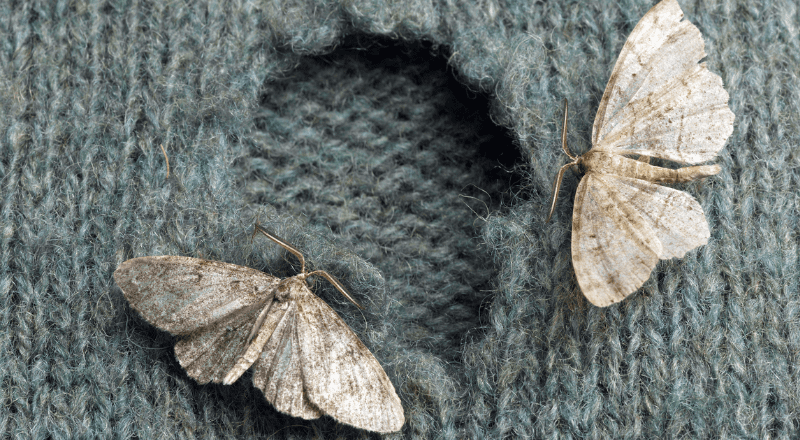
Imagine this.. you are getting ready for the day, you open your closet door and pull out your most favorite winter sweater. All of a sudden, you notice a gaping hole in your sweater. Well, believe it or not, this happens more often than you may think. How that hole got there isn’t exactly a mystery. The culprit is more than likely clothing moths. Just because you you may never see them flying around your home or your bedroom, don’t immediately think that they are not there. Clothing moths are nocturnal and they tend to camouflage themselves in tight, dark spaces.
So, what’s the deal with clothing moths? Why do they ruin the fabrics of our favorite clothing? How do we get rid of them? Keep reading to find out!
Why Clothing Moths Become Attracted To Your Clothes
Moths enjoy being in dark, enclosed spaces, so closets and drawers are their ideal places to be. They also like natural fibers of animal origin. Along with this, “the larvae feed on fabric that has bodily fluid on it, like sweat, saliva, oil and sometimes even food” explains Joe Fryer, director of operations for New York-based JP McHale Pest Management Inc.
While the larvae are at first attracted to natural or animal fiber, they could also have an attraction to synthetic fiber soiled with bodily fluids such as sweat or oil, or even fur from your pet. Due to the fact that moths have an attraction to bodily oils, sweat, and food/drink stains, this is why holes are often seen more frequently on the fronts and sleeve-ends of your garments.
The clothes moths lay their eggs within the fabric, and their larvae feed on the fibers. Thus, this is what creates holes. The larvae are so small that if you don’t know what to look for, you could easily miss them. They are only about a quarter to one-half inch long and leave white stringy trails, very similar to a cobweb.
What Do I Do If I Notice Clothing Moths?
If you notice a clothing moth in your closet or in your drawer, its important to isolate it in a sealed Ziploc bag or a trash bag. It is vital to keep it isolated. Overall, insects don’t like extreme temperatures, extreme cold or heat. Therefore, one option is to put your item in the dryer for 30 minutes or try a deep freeze. Remember, its important to pay close attention to the care label in order to not shrink your garment. For fine wool, cashmere and silk garments, dry cleaning will 100% get the job done in the best possible way.
How Do I Prevent Moths?
Set Out Moth Traps
These traps can be set up in your closet, chest of drawers or underneath a bed. This pest traps designed to lure and kill adult clothes moths without leaving a mothball smell on your fabric products.
Give Your Clothing A Deep Clean
Dry cleaning your most valuable clothes regularly is the best option since moths are attracted to body oils, sweat and food. Dry cleaning can kill moths, eggs and larvae without damaging the fibers.
Vacuum Your Storage Areas
Before you put any clothes or fabrics back into their normal storage bins or bags or in the storage area- including closets, drawers, chests and bureaus – thoroughly vacuum out these areas and pay special attention to any crevices or dusty areas where eggs and larvae may be accumulating. The cleaner you make your storage areas, the less likely the infestation will return. And, once done vacuuming, take your machine outside, remove the vacuum bag, seal it in a plastic bag and throw it in the trash. Always keep your vacuum clean as well! Remember, larvae can survive on dust, so get the vacuum debris out of your house.
Store Woolens in Well Lit Areas
Because, moths hate light.
Call An Exterminator
In extensive infestations, you may need to call a professional exterminator. Though this may be costly, a thorough treatment with chemical insecticides may be the ultimate solution to control this type of insect.
Hang – Don’t Stack
It’s true, clothing moths seem to prefer clothing that’s stacked on top of other clothing. This is because clothing moths prefer being in the darkness. Regardless, it’s apparent that they prefer not to dine on clothing that’s placed on a hanger or hook.
Seal Clothing Away
For your garments that don’t get regular use, get it dry-cleaned and then immediately seal it in a moth-proof container or bag. This will keep the moths from damaging these less-used items. The containers don’t need to be vacuum sealed, just closed in a bag or container that keeps moths and their larvae out.
Key Takeaways
If you begin to notice holes in your most-loved garments, the best thing to do is to call a dry cleaning service.
This will without a doubt be the best solution for your garments! Cleaning kills eggs and larvae, and specialized services done by a reputable cleaners can make sure that your clothing becomes taken care of in the best possible way.
Remember, always keep an eye out for moth holes, and don’t overreact with harsh chemicals or exterminators unless highly needed. Often, you can fix the holes if you catch the moths early. Here at Red Hanger, we’re experienced in clothing restoration. If your clothes need some patching, give us a ring!
Schedule dry cleaning with Red Hanger if you begin to have any signs of unwanted moths in your homes.